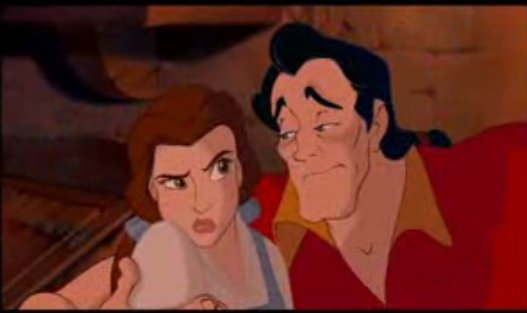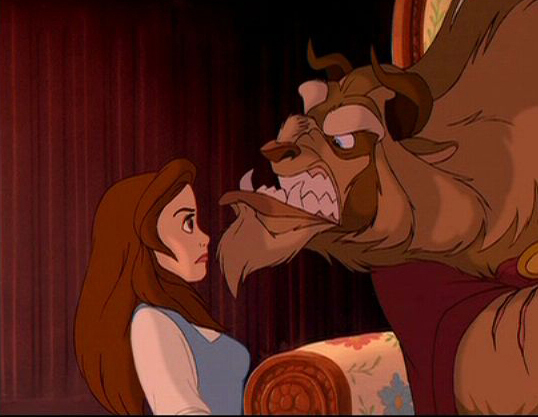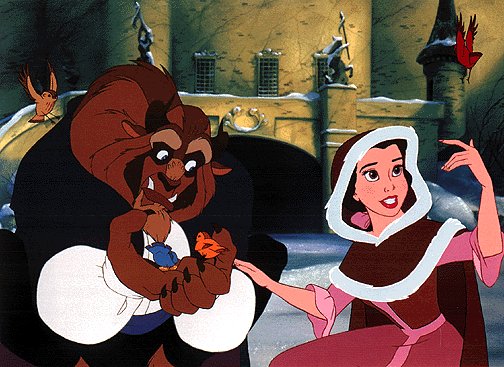Beauty and the Beast is another one of Disney's classic films that begins to emerge out of the mainstream damsel in distress notions and into featuring a stronger, more capable female lead. Belle is an eccentric, intelligent young woman who prefers to read rather than find a husband, unlike other traditional Disney princesses. She lives in a small village where everyone recognizes her for her outstanding beauty but also for her peculiarity. Belle doesn't fit in with the townspeople. They view her as odd because "her head is always stuck up in the clouds" or "she always has her nose in a book." Belle loves to read fairy tales about finding Prince Charming, but it's difficult to say she is actually looking for her "prince" herself. She seems quite content with the way life is, living with her inventor father, Maurice. She does display certain characteristics that echo more traditional gender roles for women, such as being the caretaker to her father, but Belle demonstrates repeatedly that she won't be pushed around by anyone.
Enter Gaston. The true villain of the movie. He is a traditionally handsome, very egotistical hunter who lives in the village. He has his sights set on Belle to become his wife, not because they know each other, but because he believes she is the only one as good looking as he is, so that makes her worthy to be his bride. He is the epitome of strong male stereotypes. Aggressive, demanding, tough. Nuray Sakalli-Ugurlu says in her article "According to traditional stereotypes, men are supposed to be leaders who are assertive, dominant decision makers in romantic relationships, whereas women are supposed to be submissive, passive conformists." In Gaston's perspective, these ideas are true. Not once does he consider Belle's feelings on marrying him, but automatically assumes she will. He's Gaston, after all, so who wouldn't want to marry him? Belle on the other hand does not abide by these standards and instead acts very strong-minded about the issue. When he propositions her, Belle immediately rejects him, repulsed by the idea of being stuck as his wife. She ducks out of the way when he tries to kiss her and he lands in a pile of mud. Gaston, though offended and annoyed, certainly does not give up his pursuit for her affections and later it comes back to bite him.

The interesting piece to this is that there are three young, blonde village girls constantly fawning over Gaston, every bit of the perfect stereotypical white female. They are each highly sexualized and in one scene even push a water pump down with their breasts instead of their hands. Gaston rarely pays them any attention, but rather uses them to make himself look good. The bar in town is very distinctly male, with animal mounts covering the walls, drinking and fighting, and only men are inside except for these three girls Disney credited as "Bimbettes". Perhaps Gaston is merely intrigued by the challenge Belle presents for him.

Maurice, Belle's father, invents a chopping machine that he takes to show off at a fair. Along the way, he gets lost in the woods and attacked by wolves. He stumbles across the Beast's castle in desperate need of help. The Beast finds out that his servants allowed Maurice to come inside and furious, he locks the old man away in a dungeon. Phillipee, Maurice's horse, returns to the village without him, alarming Belle and she goes off to find him. Upon arriving to the castle, the servants are all distinctly aware that a girl is there, because that is the only way to break the spell. When Belle finds her father, she offers to take his place to free him, and the Beast steps into the light so she can see her. She is shocked, but still stands her ground, demanding to stay at the castle if her father can be freed. This is particularly significant, because unlike the princesses before her, Belle is taking initiative and putting herself in what could presumably be a dangerous situation. The Beast finally agrees and sends her father away without letting them say goodbye, which only furthers Belle's loathing for him. This is one of the first times we see the two leads hate one another before beginning a romantic relationship, which is much different compared to the love at first sight themes of the earlier films.

The Beast and Belle fight and argue quite a bit. He demands her attendance at dinner, and she refuses. He orders her to stay out of the west wing, and she disobeys, finding the rose that holds the spell over the Beast. He becomes enraged that she has found his secret and Belle escapes the castle to get away. Again, unlike previous female leads, she is not playing helpless and waiting around for someone to come rescue her, but taking matters into her own hands. In contrast though, she does get attacked by the same wolves that attacked her father, suddenly casting her into a more victimized role and the Beast saves her, but not without sustaining an injury. Back at the castle, Belle tends to his wounds. Despite the way she breaks the status quo of female stereotypes, she is not without these qualities that show she can be domestic when the need arises. It is interesting though that while she is treating his wound, the Beast acts more like a child rather than the dominant, aggressive qualities from before. He whines and complains about cleaning the injury and Belle, though still maintaining that sense of domesticity, becomes the dominant person in this particular interaction, picking away at his stubbornness to in order to help him.

This is where the relationship between Belle and Beast shifts. They start getting to know one another and slowly become friends over the course of her time spent in the castle. This is the first time we see a romantic relationship build and blossom because they two take the time learning about each other rather than immediately falling in love and riding off into the sunset. Belle and the Beast even started out hating one another, so it's a huge improvement on Disney's part to see a more realistic way a relationship starts rather than the romanticized way they had been perpetuating. In a sense, Belle is helping him to rediscover his humanity. He's been stuck as a Beast for so long and has been keeping company with nothing but his anger and self-pity. Belle is a positive influence on his attitude and behavior and the audience can see the drastic change she encourages in him.

One night, the Beast allows Belle to look through a magical mirror to see her father. He is stumbling around in the woods, terribly sick, and despite it being the last night to earn Belle's love to break the spell, the Beast frees her to go save her father. In The Little Mermaid Ariel was the one who was forced to sacrifice everything for her love, but in this case, the Beast is giving up ever becoming a human again so Belle can be happy. Back at the village after Belle finds her father, the town wants to lock Maurice away because they think he's gone mad, claiming there is a Beast. Belle uses the magic mirror to clear her father's name, but also says regardless of his appearance, the Beast is her friend and very kind.
In a fit of jealousy, Gaston riles up the mob and charges into the woods, determined to kill the Beast. The servants at the castle manage to push back the mob and keep them out, but Gaston goes after the Beast personally. The Beast doesn't have the will to fight back because he's depressed that Belle left, but when she returns to the castle, he begins to. He's about to kill Gaston, but then chooses not to because he's been changed into a better person; however, Gaston takes advantage of the moment and stabs him, but then slips and falls to his death. Belle arrives, finding the Beast incredibly hurt. She tells him that she was intending to come back and she loves him as the last petal on the rose falls. The Beast is returned to his human form as well as the servants of the castle since the spell was broken and the movie fades out with the two of them dancing in the great hall, seemingly very much in love.

Beauty and the Beast did manage to keep some of the more traditional gender roles intact within the plot, but the very opinionated, strong-willed female lead is really what drove the story. She broke of the conformity of damsels in distress, instead always taking action when in a bad situation rather than waiting for someone else to help. She also did not fall into the themes of love at first sight, rather choosing her own lover only after taking the time to get to know him. Belle is a much more progressive role model for the younger audience than previous female leads who rarely showed much in the way of thinking for themselves.
No comments:
Post a Comment